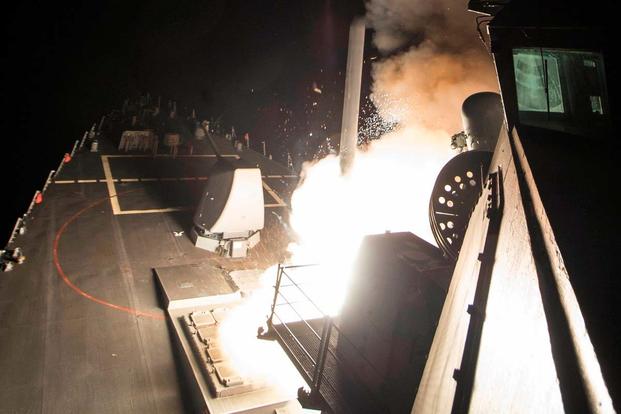ABOARD THE USS GEORGE H. W. BUSH, PERSIAN GULF -- After months of polishing perfection in dry runs, watching the U.S. Navy destroyers Ross and Porter unleash 59 Tomahawk Land Attack Missiles on a Syrian airfield April 7 from his remote vantage point in the Persian Gulf was exhilarating, the officer who helped coordinate the strike said.
Lt. Commander Wilbur Hines, the TLAM officer for the George H. W. Bush carrier strike group, said he watched the strike and received real-time updates on its impact from a special planning location on the ship -- hundreds of miles away from the location of the Ross and Porter in the Mediterranean.
While the destroyers are not part of the Bush strike group, the two areas of operation coordinate closely on Tomahawk missions and training, and the strike group commander, Rear Adm. Ken Whitesell, oversaw the recent mission.
"It was pretty exciting," Hines said. "We had one member on my team that had never been involved in a real-world tasking, a real Tomahawk strike. So he was elated that not only was he involved in the strike, but one of the ships has the same name as his ... Ross. It's sort of a strange alignment of the cosmos to allow him to be the last member of our team to be able to say, 'I shot Tomahawks, real-world.'"
While all Navy guided-missile destroyers and cruisers are equipped with TLAMs, occasions in which teams are called upon to fire the $1 million missiles are understandably rare. The missiles, with a range of 1,000 miles or more, are reserved for key long-range, precision-strike missions. They're often relied on for a rapid, and surgical, military response.
Before the early-morning strike, which targeted Shayrat Airfield in Syria and destroyed 20 Syrian aircraft and other infrastructure, the last time the Navy fired Tomahawks was in October. That strike, launched from the destroyer Nitze, took out three radar sites on the coast of Yemen that had been used to target a Navy destroyer in the region. Prior to that, the last Tomahawk strike had been in 2014, when 47 TLAMs were launched from the destroyer Arleigh Burke and the cruiser Philippine Sea against multiple Islamic State and Khorasan Group targets in Syria.
Training on the employment of the weapons system is incessant, Hines said. Exercises happen daily, he said, often involving ships in the 5th Fleet, which includes the Middle East, as well as the 6th Fleet, which includes the Mediterranean. Sailors attached to the mission are routinely reminded that it must be executed with perfection, but Whitesell put a special emphasis on this point at the start of the Bush's deployment in January, Hines said.
"[He said], 'this is a no-fail mission area,' and that idea has permeated amongst all the ships and it's resting in our TLAM cell, and we all believe it," he said. "I think when you look at all the different ways that the Navy has employed force in situations that arise around the world, I think they can all kind of point to a strategic option that has been utilized over time. I think Tomahawk is more than a likely option that has been utilized over the last several years. And so that's behind the heavy emphasis on it being a no-fail mission."
Word came to the strike group days ahead of the actual strike that it was in planning, Whitesell told Military.com in an interview.
"That allowed us to do some practice; it allowed us to double-check our equipment was up to speed," he said. "The mission itself was kept pretty quiet until right up near execution time."
For Hines, the critical hours before the strike were spent in overwater planning and deconfliction, and making sure the system where launch planning occurred -- the maritime Global Command and Control System -- was at peak accuracy.
Hines said the plan had to take into account commercial ships, prohibited flight areas, variables regarding launching missiles from a ship rather than a ground location, and even coordinates to make sure the missiles did not hit each other in mid-air. On the carrier alone, he said, a team of six worked deconfliction and the logistics of execution.
"We prepared, we did all the necessary planning, we shook every issue that could arise. We brought it to light, we corrected and mitigated it. We came up with a good game plan to execute and we practiced, practiced, practiced," he said. And then we waited, and executed."
While the standard of precision and perfection did not differ from mission to execution, Hines said the high-profile nature of the mission was felt by planners.
"It's one thing when you know you're doing a scenario because you're trying to stay perfect and trying to stay proficient," he said. "It's [another] to know you're executing national level tasking for the president in response to or for the purpose of achieving a strategic objective. There's a different level of interest."
As for Whitesell, he said the execution of the strike was remarkable in the level of calm surrounding it.
"It was surreal in the fact that nothing changes," he said. "There was no, 'oh, this is the real thing,' any exclamation points to what they were doing. They just realized, okay, this is the real thing. It is no different because we train exactly the way we would for a real event ... I expected nothing different, honestly."
-- Hope Hodge Seck can be reached at hope.seck@military.com. Follow her on Twitter at @HopeSeck.































